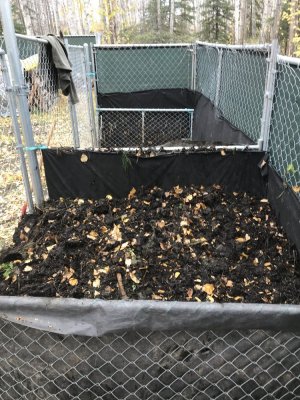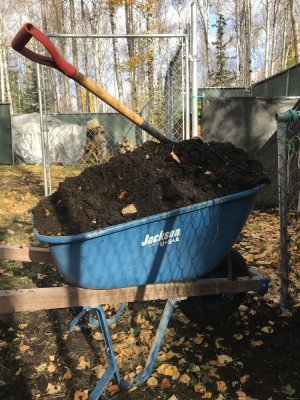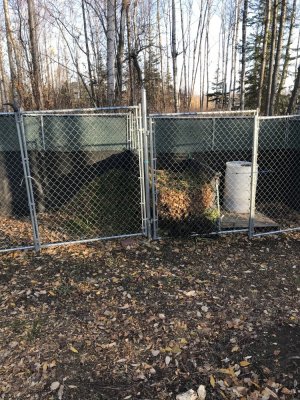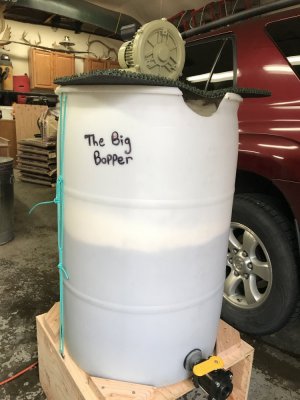Alasgun
Deeply Rooted
The word Compost covers a lot of ground which we try to utilize in many ways. We started with a worm bin which proved to be a lot of work for the return, it worked fine but i’m generally busy enough that i watch for ways to cut effort / maximize return! Vermi-composting was painfully slow when we just added the kitchen scraps each day so i bought a Big blender that liquified the stuff and seemed to speed up the process. However, that only worked for kitchen waste, and at the end of a year i had generated roughly 50 lbs of worm castings. Hum, i can buy that much organic worm castings for $60 bucks, not the best return for my effort.
Then we went the bin route which we continue to this day, with upgrades. Our initial set up was two bins made up of 4 Pallets each, screwed together to give a 4x8 working area in each section. Now we could handle All the waste without having to separate, grind and tend the worm bin each day. My biggest input is the bagged grass clippings (green category) which keep everything moving with the heat they generate. Next would be all the garden waste and lastly fall leaves.
Then i upgraded to chainlink panels which are taller, wider and longer than pallets giving me more working room while turning It. I also learned how to speed up the process by adding various ”starters” that i can make myself. Lacto bacillus serum heads the list, simply a liquid bacterial product made from milk. Each spring i’ll make a batch to have on hand for the first turning and this sped things up quite a bit. i can almost use “that years” compost the same year but prefer a more complete breakdown without having to sift the pile each fall. Remember, i’m pretty lazy!
Fish hydroslate is another input i make, using lacto to break down my fish carcasses in a poly drum. This is a slow process as well and i’ve decided i prefer to apply it directly anyway, giving a big boost where ever it’s applied. I look at it more like a vitamin shot or a first aid product now.
With the newly finished Rabbitry i’ll have a manure source which will complete the cycle as “the ultimate” compost starter! In the Dakota’s sheep manure proved it’s worth in that capacity and i’ve longed for a clean manure source for many years.
Like most, id simply turn those pile‘s 3 to 5 times during the summer and call it good; then i bought a thermometer! By utilizing it and turning based on the internal temp i was not wasting time turning it prematurely. it’s me and a fork turning a pickup size pile so knowing the right timing let’s an ole guy skate occasionally!
Compost tea, simple name and easy to generate, i have two “tea pots” and always make a batch for the indoor starts in the spring, a batch for when things are moved out to the greenhouse and garden beds and a batch for the fruit trees/bushes later on. My smaller “pot” is a 13 gallon bucket powered by a Medo linear piston pump generating 45 lpm. The other, “the big bopper” is a 50 gal poly drum powered by a regenerative blower. Both will complete a batch in 24 hrs and the value of the tea is unquestioned. It could be a complete chapter of it’s own, which i may elaborate on later. Essentially you’re breeding a quadrillion, bazillion microbes and turning them loose in your soil’s to work on various elements, making them more readily available to the plants.
Running a completely organic operation makes it nice in that i don't have to consider what i can or can’t compost. I like to tell folks “you can even eat the dirt”.
There’s many ways to play this Garden game and i wouldn't want to imply, Organic’s the only way. Everyone makes those choices for them selves, this is just the way we’ve chosen to roll! At some point i’ll elaborate on why.
This is simply an overview as much more could be said. My intention was to introduce someone to “the sport of composting” who hadn’t given it much thought previously.
Hope you find something useful in this?
Then we went the bin route which we continue to this day, with upgrades. Our initial set up was two bins made up of 4 Pallets each, screwed together to give a 4x8 working area in each section. Now we could handle All the waste without having to separate, grind and tend the worm bin each day. My biggest input is the bagged grass clippings (green category) which keep everything moving with the heat they generate. Next would be all the garden waste and lastly fall leaves.
Then i upgraded to chainlink panels which are taller, wider and longer than pallets giving me more working room while turning It. I also learned how to speed up the process by adding various ”starters” that i can make myself. Lacto bacillus serum heads the list, simply a liquid bacterial product made from milk. Each spring i’ll make a batch to have on hand for the first turning and this sped things up quite a bit. i can almost use “that years” compost the same year but prefer a more complete breakdown without having to sift the pile each fall. Remember, i’m pretty lazy!
Fish hydroslate is another input i make, using lacto to break down my fish carcasses in a poly drum. This is a slow process as well and i’ve decided i prefer to apply it directly anyway, giving a big boost where ever it’s applied. I look at it more like a vitamin shot or a first aid product now.
With the newly finished Rabbitry i’ll have a manure source which will complete the cycle as “the ultimate” compost starter! In the Dakota’s sheep manure proved it’s worth in that capacity and i’ve longed for a clean manure source for many years.
Like most, id simply turn those pile‘s 3 to 5 times during the summer and call it good; then i bought a thermometer! By utilizing it and turning based on the internal temp i was not wasting time turning it prematurely. it’s me and a fork turning a pickup size pile so knowing the right timing let’s an ole guy skate occasionally!
Compost tea, simple name and easy to generate, i have two “tea pots” and always make a batch for the indoor starts in the spring, a batch for when things are moved out to the greenhouse and garden beds and a batch for the fruit trees/bushes later on. My smaller “pot” is a 13 gallon bucket powered by a Medo linear piston pump generating 45 lpm. The other, “the big bopper” is a 50 gal poly drum powered by a regenerative blower. Both will complete a batch in 24 hrs and the value of the tea is unquestioned. It could be a complete chapter of it’s own, which i may elaborate on later. Essentially you’re breeding a quadrillion, bazillion microbes and turning them loose in your soil’s to work on various elements, making them more readily available to the plants.
Running a completely organic operation makes it nice in that i don't have to consider what i can or can’t compost. I like to tell folks “you can even eat the dirt”.
There’s many ways to play this Garden game and i wouldn't want to imply, Organic’s the only way. Everyone makes those choices for them selves, this is just the way we’ve chosen to roll! At some point i’ll elaborate on why.
This is simply an overview as much more could be said. My intention was to introduce someone to “the sport of composting” who hadn’t given it much thought previously.
Hope you find something useful in this?
Attachments
Last edited:




